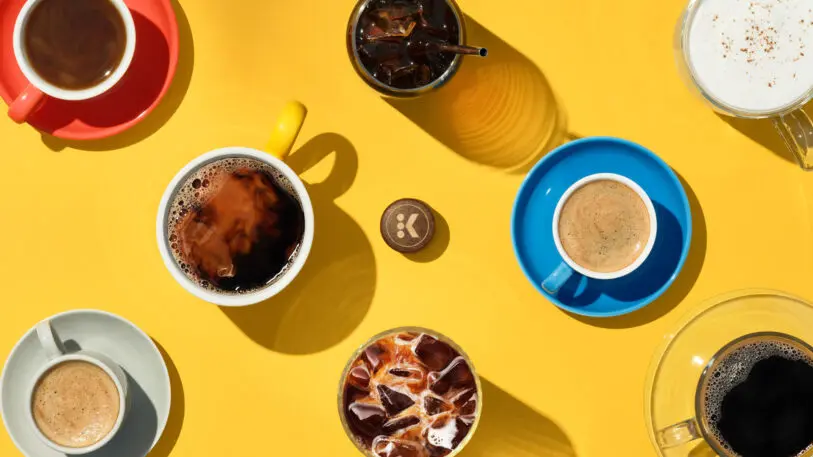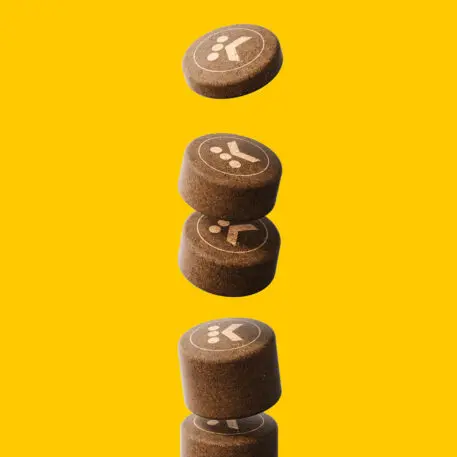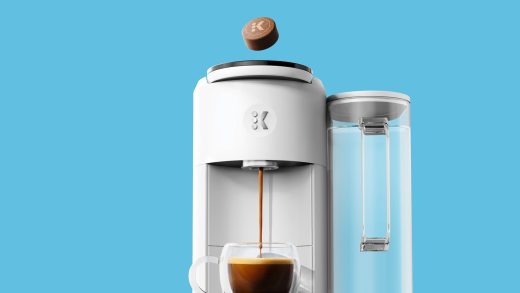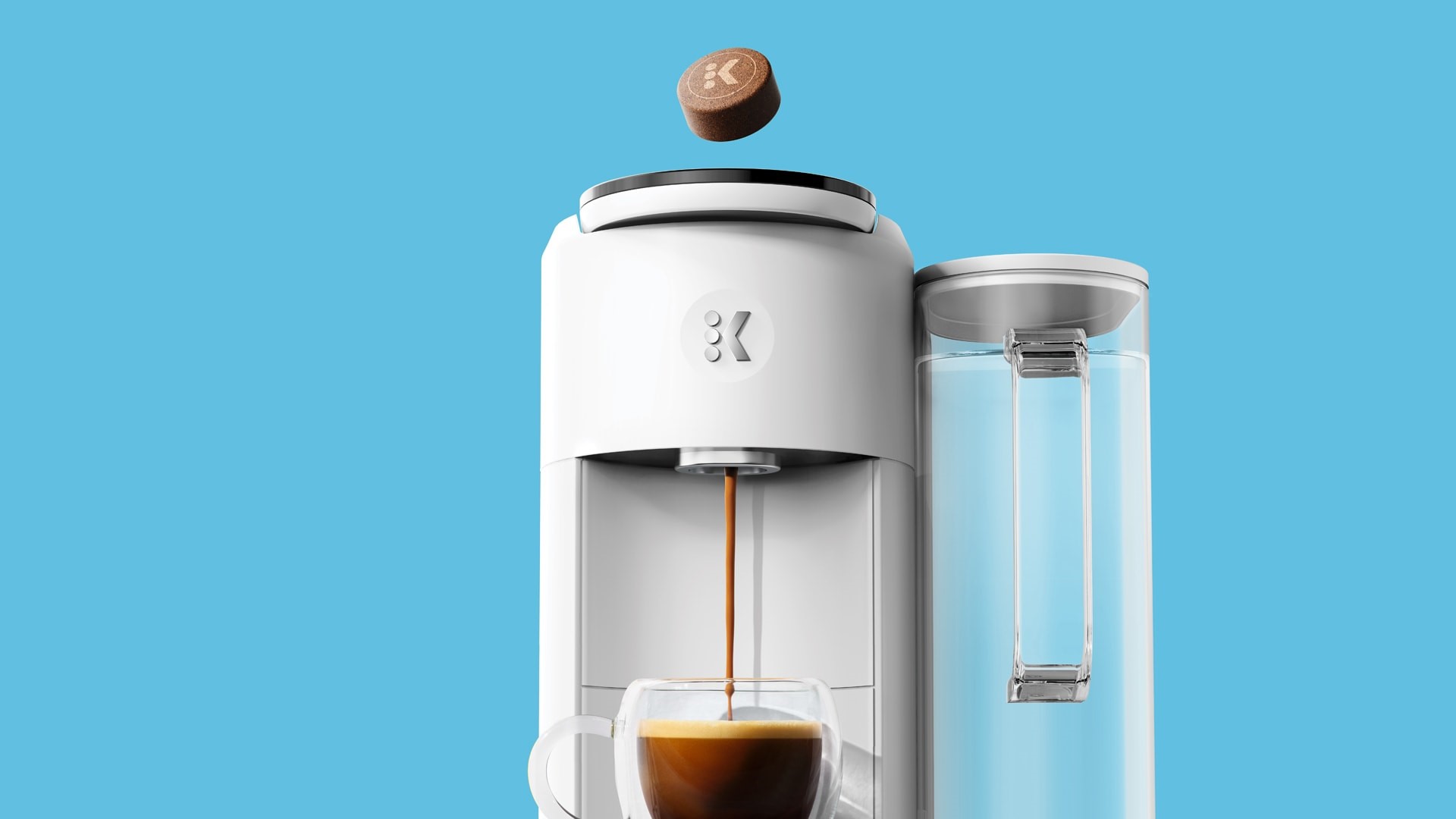How Keurig finally made a coffee pod with no plastic
How Keurig finally made a coffee pod with no plastic
Keurig’s CEO launched an in-house startup to create a new coffee system designed to put the K-Cups out of business.
In 45 million households across America—upwards of 40% of the country— the first thing people do when they wake up is make a beeline to their Keurig machine for their morning cup of coffee. Then, they toss the plastic K-Cup into the trash or recycling bin. Over the course of a year, that adds up to more than 30 billion discarded plastic capsules.
That’s about to change. Over the past few years, Keurig has been quietly redesigning its coffee system to get rid of its single-use plastic K-Cup pods. In its place, it has developed a new pod called the K-Round, which wraps the coffee grounds in a compostable coating. Keurig will begin beta-testing these K-Rounds in the fall and hopes to sell them to the public shortly thereafter.
The new K-Rounds are sleeker than the K-Cup pods that first came to market 27 years ago. When you stick these flat, round pucks of coffee grounds in Keurig’s new machines, the outer shell is punctured and water will flow through the pod to create either a hot or cold cup of coffee. The pod’s exterior, which is primarily made of food-grade algae, will end up in the machine’s refuse bin. (This new format allows the Keurig to produce espresso, which was not possible with K-Cup pods.)
Given Keurig’s enormous customer base, the K-Rounds have the potential to dramatically reduce the company’s environmental footprint. But Keurig’s size also means that it will take time for the company to roll out this new system and convince consumers to buy a new Keurig machine. In the meantime, plastic pollution—and the tiny fragments of plastic that occur when plastics break down—continues to pose a serious threat to the planet and human health.

An In-House Startup
Bob Gamgort, chairman and CEO of Keurig’s parent company, Keurig Dr Pepper, found himself in a tricky position several years ago. The K-Cup system is so woven into consumers’ everyday lives and is a significant driver of the company’s $14.8 billion in annual revenue. But at the same time, it’s clear that consumers are increasingly concerned about their environmental impact, and the K-Cup is a glaring example of single-use plastic. Indeed, Keurig’s own founder says he regrets ever inventing the K-Cup, given what a blight it has been on the environment.
“There wasn’t much of a conversation about plastic 30 years ago, when the K-Cup was invented,” Gamgort says. “So much has changed. And if you want to be a leader 30 years from now, you need to start to think about disrupting yourself, otherwise another company will disrupt you.”
Gamgort started pushing his team to develop a more sustainable approach to single-serve coffee, while also continuing to improve the sustainability of the current K-Cup pods, which are likely to remain in circulation for many more years. He says Keurig has invested heavily over the past eight years in redesigning the K-Cup to eliminate any nonrecyclable plastic, so they would be curbside recyclable; it also transitioned away from virgin plastic to recycled plastic in some brewers. But the gold standard for sustainable design is compostability, and Keurig’s design team wasn’t able to find a compostable material that could easily replace the plastic in the K-Cup in the supply chain.
Around five years ago, Gamgort invited members of the Keurig research and development team to create a separate group focused on radically reimagining how the company could deliver its single-serve coffee. This team would operate independently so they could come up with new ideas from scratch, rather than simply iterating on the status quo. “This team would have all the knowledge about consumers, technology, and coffee, as well as access to all our technology,” Gamgort says. “But I wanted them to think of themselves as a startup that would compete against us to create a better long-term solution. They started with a white sheet of paper and literally had no idea what the ultimate solution would look like.”
Gamgort also wanted to fund this team like a startup. This meant setting aside a specific amount of “seed funding” for them to prototype their solution. And then, as they came back with ideas, he would continue to create a budget that would help them get to their next stage of development, much like how startup founders keep returning to VCs for new rounds of funding.
Importantly, Gamgort didn’t want to set a particular time horizon for their work. “I’ve learned that you can’t schedule innovation,” he says. “When you say that an idea needs to be launched in 2024 and needs to hit these goals, people start to cut corners. We didn’t need a timetable; we needed the best idea.”

Plastic-Free Pods
Keurig’s innovation team didn’t start with the machine or the technology. Instead, they started with the cup of coffee they wanted to produce.
After carefully studying consumer behavior around coffee, they realized that the ultimate solution needed to be compatible with both high and low water pressure, since this can create more diverse drinks, from espresso to cold coffee. They considered eliminating the pod concept altogether and just create solid pucks of packed ground coffee, but this was problematic because the coffee would get stale quickly and consumers didn’t want to deal with the mess of grounds.
In the end, they determined they needed to create a pod, but it had to be made of a material that was eco-friendly. They scoured the market for existing solutions. This led them to a Swiss company called Delica that had developed a seaweed-based material that can hold the grounds together, but is flexible enough to expand and contract when it comes into contact with water. Keurig bought this technology from Delica for use in the North American market and made it the foundation of the new K-Round system.
In an interesting twist, Delica has its own coffee brand, Coffee B,which uses sustainable single-serve balls of coffee grounds encapsulated in the kind of digestible coating found in pills.
To use the new pods, Keurig built a new machine called the Keurig Alta that also operates with existing K-Cup pods. It was more costly and complicated to create a machine that could accommodate both kinds of capsules, since they are quite different in terms of both shape and material. But Gamgort says this was a crucial design decision. For one thing, even consumers who decide to switch to the K-Round system may have a stock of existing K-Cup pods they will want to finish. But Keurig also makes 500 different kinds of coffee in the K-Cup system, and it will be impossible to transition all of them to K-Rounds immediately. “From our many conversations with consumers, we realized this would be a way to enable trial, while taking away the risk,” he says.
Now, Keurig is ready to begin sending the K-Rounds into the world. In the fall, it will launch its beta test with an expert panel and collect as much data as possible to continue iterating on the technology. One thing they will be trying to figure out is exactly how much these new products should cost. Gamgort says the goal is to make this new system affordable, but there’s also some variation in how much current Keurig machines cost, from $49 to $200.
Ultimately, Keurig believes the new K-Rounds will be ready to hit the market in a matter of months. Keurig has worked hard to make the transition to these new pods as seamless as possible. Gamgort has pushed this team to create a solution that doesn’t compromise on convenience, affordability, or quality. But it’s unclear how many consumers will be willing to buy the new machine or how long it will take to completely eradicate the plastic K-Cup pods.
Gamgort believes it is better for Keurig to be tackling these issues now, rather than in years to come. “There’s a saying inside this company, which is that you don’t shop when you’re hungry,” he says. “The best time to launch a new product is when you don’t need to launch it. And for us, that time is now.”
Recognize your company’s culture of innovation by applying to this year’s Best Workplaces for Innovators Awards before the final deadline, April 5.
ABOUT THE AUTHOR
Fast Company – co-design
(13)



